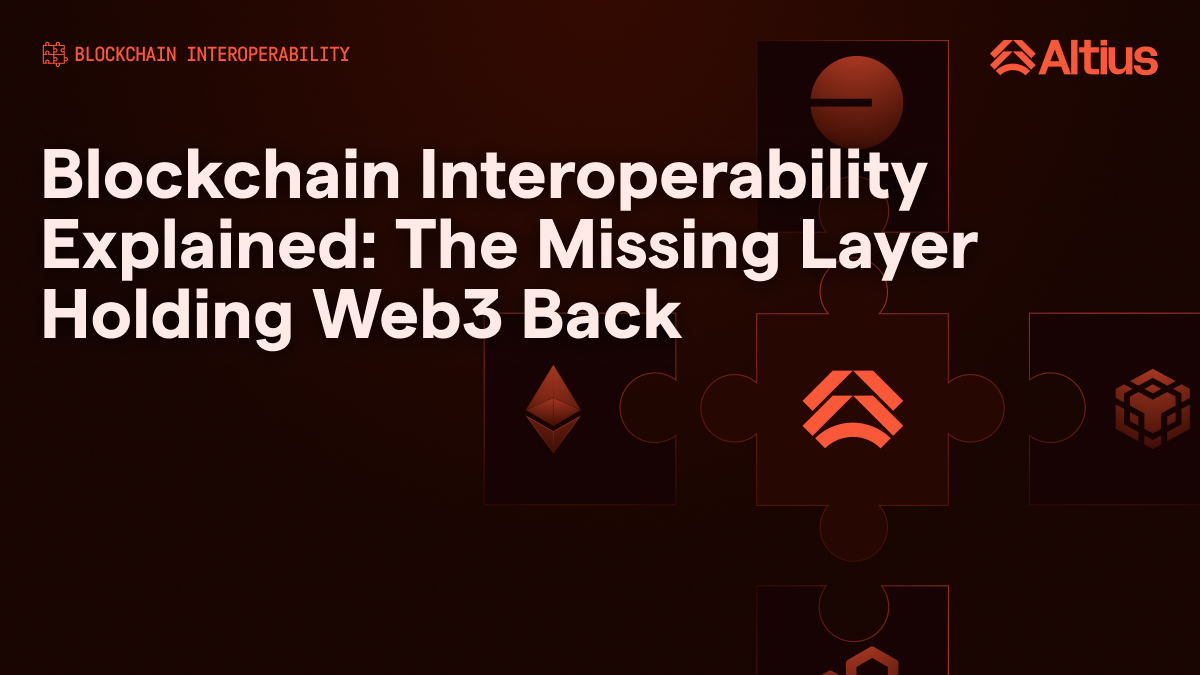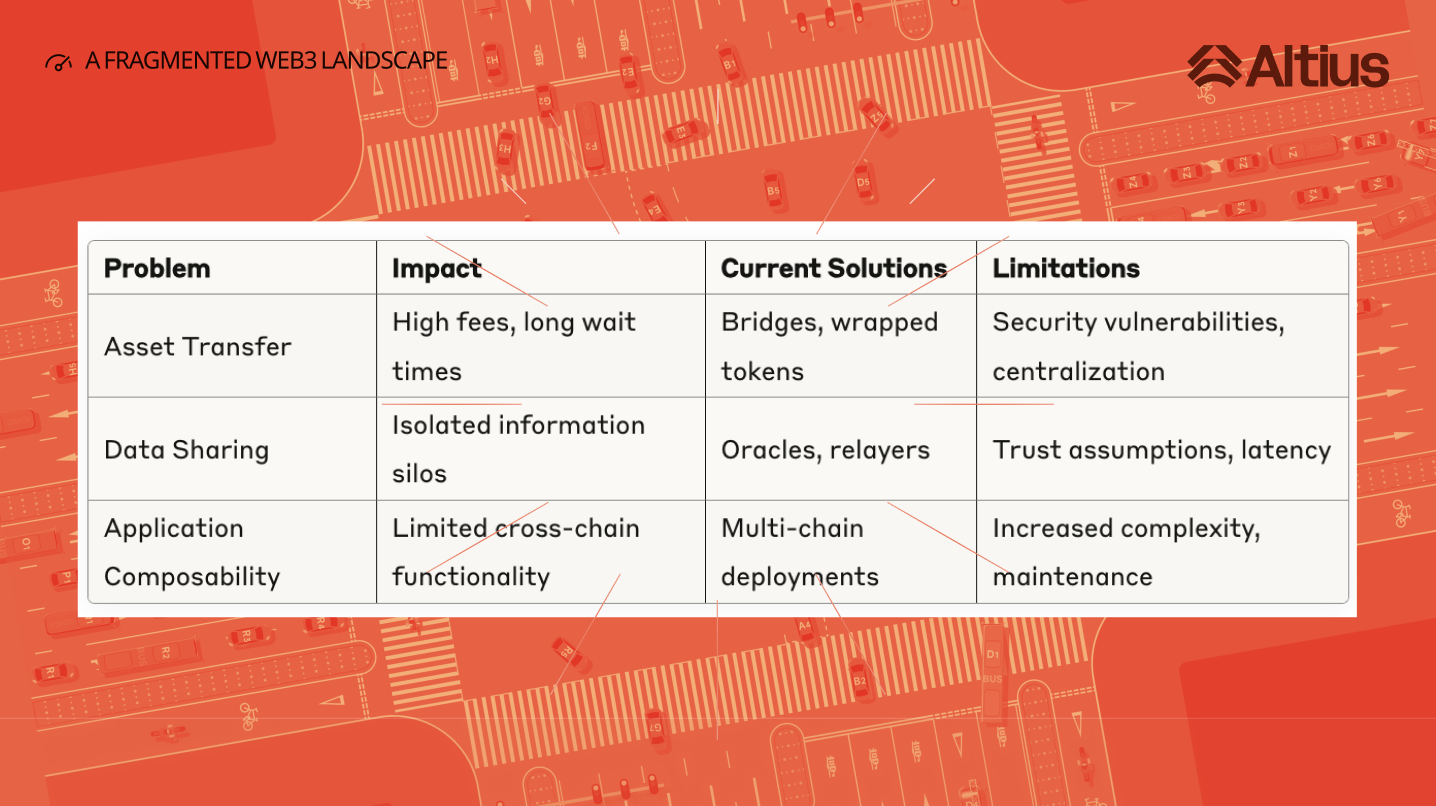Blockchain Interoperability Explained: The Missing Layer Holding Web3 Back

Picture this: you're trying to move your digital assets from Ethereum to Solana, but you're forced to navigate through multiple bridges, pay hefty fees, and worry about security vulnerabilities that have already cost the industry over $2 billion in stolen funds. Sound familiar? You're experiencing firsthand the biggest bottleneck holding back Web3's mass adoption—the lack of true blockchain interoperability.
As the CTO of Altius Labs, I've witnessed this problem evolve from a minor inconvenience to an existential threat to Web3's future. Today, we have hundreds of blockchains and Layer 2 solutions, each promising to be the "Ethereum killer" or the "next big thing." But here's the uncomfortable truth: we've created a fragmented digital archipelago where value and innovation remain trapped in isolated silos.

What Exactly Is Blockchain Interoperability?
Blockchain interoperability is the ability for different blockchain networks to communicate, share data, and transfer value seamlessly without intermediaries. Think of it as the digital equivalent of being able to send an email from Gmail to Outlook—it should just work, regardless of the underlying infrastructure.
In Web3's current state, moving assets between chains is like trying to send a letter from New York to London using carrier pigeons. It's possible, but it's slow, expensive, and fraught with risks. True interoperability solutions should enable seamless cross-chain communication, allowing applications to leverage the unique strengths of different networks without forcing users into complex, multi-step processes.
The Core Components of Interoperability
Effective blockchain interoperability requires several key elements working in harmony:
Cross-Chain Messaging: The ability to send verifiable information between different blockchain networks safely and efficiently.
Asset Portability: Moving tokens and digital assets across chains while maintaining their integrity and value.
Smart Contract Composability: Enabling applications on one chain to interact with smart contracts on another, unlocking new possibilities for decentralized finance and beyond.
Shared Security Models: Ensuring that cross-chain interactions don't compromise the security guarantees of the participating networks.
The Current State: A Fragmented Web3 Landscape
Web3's explosive growth has created an unprecedented challenge. We now have over 100 active blockchain networks, each with its own consensus mechanism, virtual machine, and ecosystem. Ethereum processes about 1.2 million transactions daily, while Solana handles over 40 million. Bitcoin remains the store of value king, and new Layer 2 solutions launch monthly.
This fragmentation creates several critical problems:
User Experience Nightmare: Users must maintain multiple wallets, understand different gas tokens, and navigate complex bridge interfaces just to access applications across chains.
Liquidity Fragmentation: The same assets exist in multiple wrapped versions across different chains, creating inefficient markets and confusing user experiences.
Developer Complexity: Building truly multi-chain applications requires expertise across multiple programming languages, consensus mechanisms, and security models.

At Altius Labs, we've seen firsthand how this fragmentation limits innovation. Developers spend more time building infrastructure to handle multi-chain complexity than focusing on creating unique user experiences. This is precisely why we've focused on building modular execution infrastructure that can plug into any blockchain—because the future of Web3 isn't about picking winners and losers, it's about enabling seamless collaboration between networks.
Current Interoperability Solutions: Bridges, Wrapped Tokens, and Their Limitations
The blockchain industry has developed several approaches to tackle interoperability, but each comes with significant trade-offs that highlight why we haven't solved this problem yet.
Blockchain Bridges: The Current Standard
Blockchain bridges currently dominate the interoperability landscape, facilitating billions of dollars in cross-chain transfers annually. These systems typically work by locking assets on one chain and minting equivalent representations on another. Popular bridges like Wormhole, Multichain, and Stargate have processed hundreds of billions in transaction volume.
However, cross-chain bridges have become the primary attack vector for hackers, with exploits accounting for over 57% of total Web3 losses in recent years. The fundamental issue is that bridges create honeypots—large pools of locked assets protected by smart contracts that may have vulnerabilities or depend on trusted operators.
Consider the Harmony Bridge hack in 2022, where attackers compromised the bridge's multisig wallet and drained $100 million. Or the more recent Orbit Chain exploit in 2024, where seven out of ten multisig signers were compromised. These incidents aren't outliers—they're systemic risks inherent to current bridge architectures.
Wrapped Tokens: A Necessary Evil
Wrapped tokens represent another approach to cross-chain asset movement. When you wrap Bitcoin to use it on Ethereum (WBTC), you're essentially depositing your Bitcoin with a custodian who issues you an equivalent ERC-20 token. While this enables cross-chain liquidity, it introduces centralization risks and trust dependencies.
The wrapped token model also creates liquidity fragmentation. We now have multiple versions of the same asset across different chains—WBTC, renBTC, and sBTC on Ethereum, or USDC.e versus native USDC on various Layer 2 networks. This fragmentation confuses users and creates inefficient markets.
The Trust vs. Security Dilemma
Most current interoperability solutions force users to choose between security and convenience. Faster, more convenient bridges often rely on trusted operators or simplified security models. More secure solutions, like canonical bridges maintained by the underlying protocols, are often slower and more expensive.
This trade-off exists because current solutions treat interoperability as an afterthought—a bridge between incompatible systems rather than a fundamental design principle. At Altius Labs, we believe this approach is fundamentally flawed.
The Security Challenge: Why Current Solutions Keep Getting Hacked
The security challenges in blockchain interoperability run deeper than smart contract bugs or operational failures. They're architectural problems that require rethinking how we design cross-chain systems.
Smart Contract Complexity
Cross-chain bridges are inherently complex systems that must handle multiple consensus mechanisms, validate proofs from different networks, and manage large amounts of locked assets. This complexity creates numerous attack surfaces:
Validation Logic Bugs: Bridges must verify transactions and state changes from foreign chains, often using simplified light clients or oracle systems that can be manipulated.
Economic Attacks: Many bridges rely on economic incentives to ensure honest behavior, but these mechanisms can be gamed when the potential rewards exceed the staked security.
Governance Exploits: Upgradeable bridge contracts controlled by multi-signature wallets or governance tokens create centralized points of failure.
The Multisig Problem
Many bridges rely on multisignature wallets where a subset of trusted operators must approve cross-chain transactions. While this seems reasonable, it creates several problems:
- Key Management: Securely managing private keys across multiple parties is challenging, especially when operators are geographically distributed.
- Collusion Risk: If a majority of operators are compromised or collude, they can drain the bridge's funds.
- Operational Complexity: Coordinating among multiple parties for routine operations creates delays and potential points of failure.
Liquidity and Economic Risks
Beyond technical vulnerabilities, cross-chain systems face economic risks that can be just as devastating:
Liquidity Drains: During market stress, users may rush to withdraw assets from one chain, creating liquidity imbalances that can break bridge operations.
Oracle Manipulation: Many bridges rely on price oracles to determine exchange rates or validate transaction values, making them vulnerable to oracle manipulation attacks.
MEV Extraction: Sophisticated attackers can exploit cross-chain arbitrage opportunities or manipulate transaction ordering to extract value from bridge users.
What True Interoperability Looks Like
True blockchain interoperability isn't just about moving tokens between chains—it's about creating a unified experience where users and applications can seamlessly access the best features of different networks without friction or security compromises.
Seamless User Experience
In a truly interoperable Web3, users shouldn't need to understand the underlying blockchain architecture. They should be able to:
- Use any application regardless of which chain it's deployed on
- Pay transaction fees in their preferred token, regardless of the destination chain
- Maintain a single wallet that works across all networks
- Access the best prices and liquidity across all available markets
Application-Layer Composability
True interoperability enables applications to become truly modular, leveraging the unique strengths of different chains:
Settlement on Bitcoin: For maximum security and censorship resistance Execution on High-Performance Chains: For complex computations and high-frequency operations
Data Availability on Specialized Networks: For efficient and cost-effective data storage Privacy on Zero-Knowledge Networks: For confidential transactions and computations
This is where Altius Labs' modular execution approach becomes particularly relevant. By decoupling execution from consensus and data availability, we enable applications to optimize for performance while maintaining security and interoperability.
Native Cross-Chain Standards
Rather than bolting interoperability onto existing systems, future blockchain architectures should be designed with interoperability as a core feature:
Shared State Management: Applications should be able to maintain consistent state across multiple chains without complex synchronization mechanisms.
Universal Addressing: A single addressing scheme that works across all networks, eliminating the need for wrapped tokens or chain-specific identifiers.
Cross-Chain Smart Contracts: Smart contracts that can execute logic across multiple chains as part of a single transaction.
The Path Forward: Modular Blockchain Architecture and Standards
The solution to blockchain interoperability isn't better bridges—it's fundamentally rethinking how we design blockchain systems. The future lies in modular architecture that treats interoperability as a first-class design principle rather than an afterthought.
Modular vs. Monolithic Design
Traditional blockchain architectures bundle consensus, execution, and data availability into a single monolithic system. This approach worked for early networks like Bitcoin and Ethereum, but it creates unnecessary coupling that limits interoperability.
Modular blockchain architecture separates these concerns:
Consensus Layer: Focuses solely on ordering transactions and maintaining network security Execution Layer: Handles transaction processing and state transitions Data Availability Layer: Ensures transaction data is available for verification Settlement Layer: Provides final dispute resolution and security guarantees
This separation enables what we call "plug-and-play interoperability"—different modules can be mixed and matched based on application requirements while maintaining security and compatibility.
The Role of Shared Standards
True interoperability requires industry-wide standards that work across different blockchain architectures. Several promising initiatives are emerging:
Inter-Blockchain Communication (IBC): Originally developed for the Cosmos ecosystem, IBC provides a protocol for authenticated communication between different chains.
Cross-Chain Transfer Protocol (CCTP): Circle's standard for native USDC transfers across chains without wrapped tokens.
Universal Account Abstraction: Standards that enable users to interact with any chain using a single account interface.
At Altius Labs, we're building our execution infrastructure to support these emerging standards while maintaining compatibility with existing networks. Our VM-agnostic approach means applications can deploy once and run anywhere, regardless of the underlying blockchain architecture.
Practical Implementation Strategies
Building truly interoperable systems requires careful attention to several key areas:
Security-First Design
Rather than sacrificing security for interoperability, new systems should maintain the security guarantees of their underlying networks:
- Inherited Security: Cross-chain operations should inherit the security of the most secure participating network
- Cryptographic Verification: All cross-chain communications should be cryptographically verifiable without trusted intermediaries
- Economic Alignment: Incentive structures should make attacks economically irrational
Developer Experience
Interoperability shouldn't increase complexity for developers:
- Unified APIs: Developers should use the same interfaces regardless of deployment target
- Automatic Optimization: Infrastructure should automatically optimize for the best available execution environment
- Seamless Migration: Applications should be able to migrate between networks without rewriting code
Altius Labs' Approach to Solving Interoperability
At Altius Labs, we've taken a fundamentally different approach to blockchain interoperability. Rather than building another bridge or creating yet another new chain, we've focused on solving the underlying problem: the tight coupling between execution and consensus that makes true interoperability so difficult.
The Altius Stack: Modular Execution Infrastructure
Our solution centers on the Altius Stack—a high-performance, VM-agnostic execution layer that can plug into any blockchain network. This approach addresses several key challenges:
Performance Without Fragmentation: Instead of launching new chains to achieve better performance, we enable existing networks to upgrade their execution capabilities instantly.
Universal Compatibility: Our VM-agnostic design means applications can run on any network in our ecosystem without modification.
Maintained Security: Applications inherit the security guarantees of their chosen consensus layer while benefiting from optimized execution.
Technical Innovation Highlights
Our approach includes several key innovations that directly address interoperability challenges:
Parallel Execution Architecture
Our resolver component identifies transaction dependencies at the instruction level, enabling massive parallelization that scales with network demand. This isn't just about speed—it's about enabling applications that would be impossible on traditional sequential execution models.
State Sharding
By dividing state across multiple shards that can run on commodity hardware, we eliminate the bottlenecks that force developers to choose between different chains based on capacity constraints.
Economic Incentives for Efficiency
Our coordinator rewards developers for writing more efficient code, creating a positive feedback loop that continuously improves the entire ecosystem's performance.
Real-World Impact
The modular execution approach has profound implications for interoperability:
Reduced Migration Costs: Applications can upgrade their execution environment without changing chains or rewriting code.
Cross-Chain Composability: Applications running on Altius infrastructure can interact seamlessly regardless of their underlying consensus layer.
Future-Proof Architecture: As new consensus mechanisms and execution environments emerge, applications can adopt them without disruption.
Looking Ahead: The Future of Web3 Interoperability
The blockchain industry is at an inflection point. We can continue building bridges between incompatible systems, creating an increasingly complex and fragile web of interconnections. Or we can take a step back and build interoperability into the foundation of Web3 infrastructure.
Emerging Trends and Technologies
Several technological developments are converging to make true interoperability possible:
Zero-Knowledge Proofs: Enable private, verifiable cross-chain communications without revealing sensitive data.
Account Abstraction: Allows users to interact with any network using familiar interfaces and payment methods.
Shared Sequencing: Multiple chains can share the same transaction ordering, enabling atomic cross-chain operations.
Intent-Based Architecture: Users express what they want to achieve rather than how to achieve it, enabling systems to automatically optimize across chains.
The Network Effect of Interoperability
Once we achieve true interoperability, network effects will accelerate adoption exponentially. Applications will be able to access liquidity and users from all networks simultaneously. Developers will focus on building unique user experiences rather than reimplementing basic infrastructure. Users will interact with Web3 applications as easily as they use traditional web services today.
Challenges and Obstacles
Despite the promise, several challenges remain:
Coordination Problems: Getting multiple blockchain networks to adopt common standards requires unprecedented coordination.
Legacy Systems: Existing applications and infrastructure create switching costs that slow adoption of new standards.
Regulatory Uncertainty: Cross-chain operations may face additional regulatory scrutiny as governments grapple with Web3 oversight.
Technical Complexity: Building truly secure and efficient interoperability systems requires solving complex distributed systems problems.
Conclusion: Building the Infrastructure for Web3's Next Chapter
Blockchain interoperability isn't just a technical challenge—it's the key to unlocking Web3's full potential. The current landscape of isolated chains and fragile bridges is holding back innovation and limiting user adoption. We need solutions that treat interoperability as a fundamental design principle rather than an afterthought.
The path forward requires three key elements: modular blockchain architecture that separates concerns, industry-wide standards that enable seamless communication, and infrastructure that prioritizes security without sacrificing performance or user experience.
At Altius Labs, we're building this foundation by creating execution infrastructure that works across any blockchain network. Our modular approach enables applications to leverage the unique strengths of different networks while maintaining security and simplicity. This isn't just about making existing applications faster—it's about enabling entirely new categories of applications that would be impossible in today's fragmented landscape.
The future of Web3 isn't about choosing between different chains—it's about creating an interconnected ecosystem where innovation flows freely across network boundaries. By solving the interoperability challenge, we're not just improving blockchain technology; we're laying the groundwork for a truly decentralized internet that can compete with and eventually surpass traditional centralized systems.
The question isn't whether Web3 will achieve true interoperability—it's whether we'll build it the right way, with security, performance, and user experience as first-class priorities. The window for getting this right is narrowing, but the opportunity remains enormous for those willing to think beyond the limitations of today's infrastructure.
.svg)
